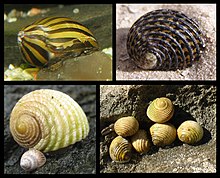Neritimorpha
| Neritimorpha Temporal range:
| |
|---|---|

| |
| Examples of Neritimorpha | |
| Scientific classification | |
| Domain: | Eukaryota |
| Kingdom: | Animalia |
| Phylum: | Mollusca |
| Class: | Gastropoda |
| Subclass: | Neritimorpha |
| Clades | |
|
See text | |
| Synonyms | |
|
Neritopsina Cox & Knight, 1960 | |
Neritimorpha is a clade of gastropod molluscs that contains around 2,000 extant species of sea snails, limpets, freshwater snails, land snails and slugs.[1] This clade used to be known as the superorder Neritopsina.
Etymology
[edit]The clade’s name, Neritimorpha, is from the Ancient Greek νηρίτης (nērī́tēs 'Nerite') and μορφή (morphḗ 'form').[2]
Description
[edit]


Despite their relatively low diversity, with only around 2,000 species, neritomorphs have achieved a remarkable diversity of forms, resembling a smaller-scale version of the diversity achieved by Gastropoda as a whole.[3] Terrestrial lifestyles have evolved at least three separate occasions in neritimorphs: the extinct Dawsonellidae and the extant Helicinidae and Hydrocenidae.[4] Neritimorphs also include the shellless, slug-like Titiscania.[3]
In all modern neritomorphs except neritopsids, the inner walls of the protoconch are resorbed.[5]
Unlike most other gastropods, neritomorphs typically have calcified opercula. There is no operculum in the shellless Titiscania, and the Phenacolepadidae have a vestigial, non-calcified operculum that shows no postlarval growth.[6]
Evolutionary history
[edit]Neritimorpha has an extremely rich geologic history, going back to early Ordovician.[5] This clade has been considered to be a leftover of early gastropod diversification.
Neritimorpha is the sister taxon of the Apogastropoda.[7][8] The clade uniting neritimorphs and apogastropods has been called either Adenogonogastropoda[9] or Angiogastropoda.[7]
All modern members of Neritimorpha are classified in the order Cycloneritimorpha.[5] Neritopsoidea was the first of the four modern neritomorph superfamilies to diverge from the others.[4]
1997 taxonomy
[edit]According to the taxonomy of the Gastropoda (Ponder & Lindberg, 1997) Neritopsina is a gastropod superorder in the subclass Orthogastropoda. The superfamily Palaeotrochoidea is contained within Neritopsina but its order placement is undetermined.
2005 taxonomy
[edit]The taxonomy of the Gastropoda by Bouchet & Rocroi, 2005[10] categorizes Neritimorpha as a gastropod mollusk clade. It is one of the 6 highest clades in Gastropoda. It contains the clades Cyrtoneritimorpha, Cycloneritimorpha, as well as Paleozoic Neritimorpha of uncertain position.
Clades (and uncertain position taxa) in Neritimorpha include:
- † Paleozoic Neritimorpha of uncertain position
- † clade Cyrtoneritimorpha
- clade Cycloneritimorpha
Four extant superfamilies are recognised: Helicinoidea, Hydrocenoidea, Neritoidea and Neritopsoidea.
In human society
[edit]Nerite snails are popular in the aquarium trade.[11]
References
[edit]- ^ Uribe, Juan E.; Colgan, Don; Castro, Lyda R.; Kano, Yasunori; Zardoya, Rafael (2016-11-01). "Phylogenetic relationships among superfamilies of Neritimorpha (Mollusca: Gastropoda)". Molecular Phylogenetics and Evolution. 104: 21–31. doi:10.1016/j.ympev.2016.07.021. hdl:10261/156227. ISSN 1055-7903. PMID 27456746.
- ^ Bailly, Dictionnaire Grec Francais. 1935.
- ^ a b Uribe, Juan E.; Colgan, Don; Castro, Lyda R.; Kano, Yasunori; Zardoya, Rafael (2016-07-22). "Phylogenetic relationships among superfamilies of Neritimorpha (Mollusca: Gastropoda)". Molecular Phylogenetics and Evolution. 104: 21–31. doi:10.1016/j.ympev.2016.07.021. hdl:10261/156227. ISSN 1055-7903.
- ^ a b Kano, Yasunori; Chiba, Satoshi; Kase, Tomoki (2002-12-07). "Major adaptive radiation in neritopsine gastropods estimated from 28S rRNA sequences and fossil records". Proceedings of the Royal Society of London. Series B: Biological Sciences. 269 (1508): 2457–2465. doi:10.1098/rspb.2002.2178. eISSN 1471-2954. ISSN 0962-8452. PMC 1691182.
- ^ a b c Bandel, Klaus; Frýa, Jiři (1999-09-30). "Notes on the evolution and higher classification of the subclass Neritimorpha (Gastropoda) with the description of some new taxa" (PDF). Geologica et Palaeontologica. 33: 219–235.
- ^ Kano, Yasunori (September 2006). "Usefulness of the opercular nucleus for inferring early development in neritimorph gastropods". Journal of Morphology. 267 (9): 1120–1136. doi:10.1002/jmor.10458. eISSN 1097-4687. ISSN 0362-2525.
- ^ a b Cunha, Tauana Junqueira; Giribet, Gonzalo (2019-03-13). "A congruent topology for deep gastropod relationships". Proceedings of the Royal Society B: Biological Sciences. 286 (1898): 20182776. doi:10.1098/rspb.2018.2776. ISSN 0962-8452. PMC 6458328.
- ^ Uribe, Juan E; González, Vanessa L; Irisarri, Iker; Kano, Yasunori; Herbert, David G; Strong, Ellen E; Harasewych, M G (2022-10-12). "A phylogenomic backbone for gastropod molluscs". Systematic Biology. 71 (6): 1271–1280. doi:10.1093/sysbio/syac045. eISSN 1076-836X. hdl:10261/279410. ISSN 1063-5157.
- ^ Simone, Luiz Ricardo L. (2011). "Phylogeny of the Caenogastropoda (Mollusca), based on comparative morphology". Arquivos de Zoologia. 32 (4): 161–323. ISSN 0066-7870.
- ^ Bouchet P. & Rocroi J.-P. (Ed.); Frýda J., Hausdorf B., Ponder W., Valdes A. & Warén A. 2005. Classification and nomenclator of gastropod families. Malacologia: International Journal of Malacology, 47(1-2). ConchBooks: Hackenheim, Germany. ISBN 3-925919-72-4. ISSN 0076-2997. 397 pp. http://www.vliz.be/Vmdcdata/imis2/ref.php?refid=78278
- ^ "Nerite Snails: Algae Eating, Care, Lifespan, Eggs - Video". Aquarium Care Basics. Retrieved 2022-07-14.
